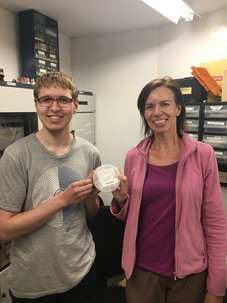Nordic Optical Telescope upgraded for planet hunting
Aarhus University student Peter Weis Hansen brought a cardboard box with him to the Canarian island of La Palma on the 11th of August.
In the box was one small ‘holographic diffuser’ that will give the Nordic Optical Telescope (NOT) at the Roque de los Muchachos Observatory on La Palma a tremendous boost in its ability to confirm planetary candidates with high precision photometry. The diffuser is already mounted on the NOT and is currently being tested. A second diffuser is currently under production. Both of them were purchased via a grant of €10 000 from the Instrumentcenter for Danish Astronomy; IDA (PI: C. von Essen) and they will be available for all Danish and other astronomers observing with the NOT.
Planet hunters using NOT will be using a.o. data from the new NASA satellite TESS. For two years at least, TESS will observe tiny variations in the light from the brightest stars due to exoplanets transiting the stars. The discoveries will be so many, that astronomers will follow up on these detections of possible exoplanets with the NOT and other ground based observatories in order to confirm and characterize them. NOT is equipped with a state of the art photometer, and the new holographic diffusers will act as a disperser improving the precision of the photometric measurements of the stellar transits.

Anlaug Amanda Djupvik accepts the small but important filter from Peter Weis Hansen.
When an exoplanet transits the disc of a star there is a successive change of the observed colour of the star. During the course of the transit, the planet will first block more red light than blue at the limb of the star, causing the integrated light of the disk to turn more blue. As the transit progresses, the planet will begin to block the lesser red coloured areas of the star as it approaches the center of the disk, leading to a change in net colour to the red, before repeating the blueward shift at egress. A high quality multicolour photometer like the one on NOT, with the help of holographic diffusers, will be able to record these changes. When they are seen, it is a confirmation that the change in the starlight is actually from a planet passing. Complementary, the same observations can in certain lucky cases be used to characterize the type of the exoplanet (gas, water or rocky) and even give some indication of the chemical constituents of the atmosphere of the exoplanet.
